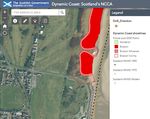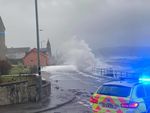Raising awareness and investing in our natural defences
←
→
Page content transcription
If your browser does not render page correctly, please read the page content below
Policy Brief
Scotland
Coast
Raising awareness and investing in
our natural defences
A coastal Policy Brief from the Interreg North Sea Region Building with Nature project
by the Dynamic Coast Project
Key messages atmospheric pressure of Storm Brendan raised the
Scotland is well placed to increase the uptake of sea surface by approximately 0.9m, allowing the
Building with Nature (BwN) approaches (Natural coincident storm waves to cause erosion and
Flood Management in Scotland) as part of renewed flooding across many areas. Some of our climate
efforts to maintain resilience, though targeted projections anticipate sea level to be raised by a
changes are required within the public and private comparable amount by 2090. Whilst Storm Brendan
sectors to realise this opportunity. The following was classified as a 1:15 year event, higher sea level
aspects require consideration, (through surges or mean sea level increases) will
leadership and support: enable smaller more frequent storms to reach further
1. Greater recognition of the importance of our up our shoreline with greater associated erosion and
existing natural defences, how these contribute flood risk.
to managing change in the future and how they
could be enhanced;
2. Improved leadership within Government, public
sector and partners in a collaborative approach
(both in terms of policy, data and on-the-ground
implementation);
3. Greater awareness and access to financial
support to ensure BwN is available (for erosion
as well as flooding) as part of an adaptive toolkit
for planning and resilience.
Sense of Urgency
The raised sea surface level during periodic storms
provide an insight into our climate-change future. In
January 2020, the surge resulting from the lowPolicy Brief
Scotland – Coast
Introduction and context
At 21,000 km, the Scottish coast is long and varied.
Only 19% (3,802 km) is potentially erodible (or ‘soft’)
and 3% (591 km) is artificial, but the distribution of
built assets tends to be clustered within these soft
and artificial coasts. It is important to recognise that
our natural defences (beaches, dunes and marshes)
protect 80% of the £18bn of coastal assets in
Scotland, with only 20% protected by artificial
defences. Thus, the existing situation in Scotland
exemplifies the importance of natural defences
and BwN approaches, even though these are
often under-recognised and under-valued by the
public and some professionals.
The importance of governance is key to the delivery Challenges
of the Interreg BwN project. Each of the European The EU-level policy brief considered three gaps,
partner organisations has policy obligations and including a Capacity Gap: limited understanding and
policy frameworks for their own shorelines. appreciation of local context, an Accountability Gap:
Underlying these are institutional and cultural lack of evidence base and instruments to effectively
‘memories’ that produce a spectrum of governance exchange experiences and a Financing Gap: or list
arrangements: in the Netherlands, the wide-scale of bankable project and business cases. Whilst we
loss of life and destruction in 1953 resulted in welcome and recognise these, from a Scottish
centralised state ownership and resourcing of coast perspective the capacity gap might include the
protection. Other countries have a more devolved evidence base, allowing accountability to consider
approach. Scotland, and others, lie at the other end policy and inter-organisational issues.
of this spectrum where national policies are set and Capacity Gap – There is a lack of awareness of the
financed, but are implemented by regional existing role of natural defences in the protection of
government (local authorities). Such a devolved assets from coastal flooding and erosion in Scotland.
approach has direct implications for the uptake of Consequently, there is insufficient understanding of
BwN approaches. the resilience or susceptibility of existing features
The Flood Risk Management (Scotland) Act 2009 both to future climate change and development
(FRM Act) does not explicitly include reference to pressure. This hampers the ability of partners to
coastal erosion, which is covered by separate but target effort in a strategic and coordinated manner.
dated legislation (Coastal Protection Act 1949) that Accountability Gap – National policies are in place
predates concerns over climate change and sea but coordination and implementation needs to be
level. Like Denmark, the responsibility of coastal enhanced. There has been mixed progress to date
erosion protection lies with the land-owner, unless mapping NFM coastal features, as well as limited
broader public benefits can justify state-funded progress to include coastal erosion as a key
intervention. However, the response in these cases consideration in flood risk; though improvements are
is limited since central government funding has been anticipated. More recent integrated approaches
directed towards flood protection rather than erosion provide opportunities to improve matters through the
protection and local authority budgets are under Scottish Climate Change Adaptation Programme 2
great pressure from conflicting demands. and collaborative working. However, organisational
Nevertheless, whilst Scotland and the Scottish coast inertia remains a concern.
is well suited to greater use of BwN, the
implementation of policy needs a more streamlined Financing Gap - The Scottish Government provides
coordinated effort in terms of alignment, data substantial and long-term capital grant for flood risk
capture, monitoring and delivery on the ground. management, which includes coastal flooding. The
£42m annually over 10 years to 2026 is allocated
according to the priorities identified in the Local
Flood Risk Management Plans (LFRMP) and
Strategies. Following an agreement with COSLA
(Convention of Scottish Local Authorities) erosionprotection works are not considered; so if local owner to lead and report back to ensure the delivery of
authorities undertake coast protection works, this SCCAP activities both internally and with partner
must be funded from their general capital grant in organisations.
competition with other demands. Where there is an
overlap with coastal flood risk and the works are Financing Gap – BwN techniques must be explicitly
included in a LFRMP, capital monies may be considered for scoping of local authority flood studies,
available. however uptake is limited. 20% of the £42m/yr funding
BwN projects typically require ongoing maintenance, (£8m/yr) is set aside for flood studies and NFM works,
not unlike civil engineering schemes, though Local but local authorities have necessarily prioritised
Authorities are often less experienced in these. development of flood studies over the implementation
Flexibility between capital and maintenance funding of NFM thus far. Although climate mitigation activities
may also be required. are progressing well in Scotland, climate adaptation
actions are rare, yet the international and national
Opportunities policy obligations are clear on the requirement of both:
It is acknowledged that the gaps in capacity, the 2016 Paris Agreement identifies the need that
accountability and financing overlap are interrelated. ‘Making finance flows consistent with a pathway
For example, the implementation (the “what to do towards… climate resilient development’ is required.
where”) is linked to Accountability (“who leads and Thus, greater awareness of the efficacy of, and
helps”) and Financing (“who pays and supports”). available funding for BwN /NFM schemes may assist
in ‘getting beyond the pilot stage’.
Capacity Gap – Greater awareness of the current
protection provided by natural features is critical to Given the scale of challenges anticipated over the
BwN uptake: the Dynamic Coast project provides a coming decades it is highly likely that a spectrum of
national evidence base for Scotland and the NFM management options (including traditional
network provides a good foundation (www.nfm.scot). engineering, BwN and hybrid approaches) will be
However, these could be improved with further required in the adaptation and protection toolkit.
Scottish, UK and EU partner exemplars to showcase
the broader use and efficacy of BwN techniques. DynamicCoast.com is a public evidence base of
Efforts to enhance our capacity should be top-down coastal changes across Scotland’s erodible shores,
and bottom-up to better include local partners. demonstrating the vital contribution natural coastal
defences play in protecting coastal infrastructure,
Accountability Gap – Coastal erosion, flooding and buildings, businesses and communities.
climate change are shared problems, and Scotland
now has coordinated programmes across Government
(Scottish Climate Change Adaptation Programme 2
(2019). We are becoming better at collaborating
across the public sector and learning from domestic
and international partners.
Despite organisational inertia, successful projects are
delivering enhancements which break down
established and silo thinking, though more needs to be
done (SEPA’s review of the NFM maps is a positive
example).
Shoreline Management Plans should be available and
updated on all coasts where assets are at risk,
allowing linkages across to Flood Risk Management
Strategies. Alongside this the Dynamic Coast project
National Flood Risk Management Network is
recommended appointment of coast champions within funded by the Scottish Government and aims to share
organisations to invigorate the coastal agenda knowledge and best practice amongst people working
internally, an approach consistent with the Committee with NFM. Case studies and guidance is available at
on Climate Change which recommended a senior www.nfm.scotPolicy Brief
Scotland – Coast
Key policy recommendations
1. Awareness raising at international -, national-, local government and local partner levels of BwN
INTERREG laboratories, NFM Network and Dynamic Coast outcomes.
2. Roadmap the pathways of international, national and local policy hierarchies, partnerships and
stakeholders to improve coordination and delivery.
3. Coordinate key datasets to identify existing and anticipated resilience / susceptibility of natural
defences and consider opportunities for enhancements. Set up a shared monitoring campaign to
ensure single authoritative national shared resource.
4. Consider supplementary funding mechanisms to enhance uptake of BwN and address the
Climate Adaptation implementation shortfall.
Image captions & credits:
1. Coastal practitioners sharing
BwN experience (J. Fitton)
2. Storm Brendan (2020.01.13)
Ardrishaig (D. Bowness)
3. Salt marsh planting at Eden
Estuary (C. Maynard)
4. Extract from Dynamic Coast
showing coastal change.
5. Dune reinstatement, St
Andrews (S. Reid)
6. Dune reinstatement, St
Andrews (A. Rennie)
CONTACT Dynamic Coast
www.DynamicCoast.com
www.northsearegion.eu/building-with-natureYou can also read

























































